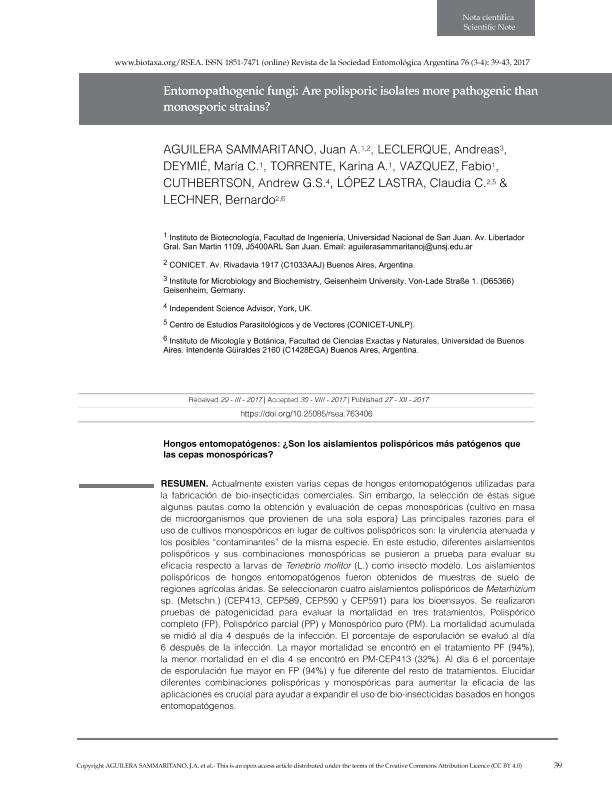Artículo
Entomopathogenic fungi: Are polisporic isolates more pathogenic than monosporic strains?
Aguilera Sammaritano, Juan Alberto ; Andreas Gunter Reiner, Leclerque; Deymié Terzi, María Celina
; Andreas Gunter Reiner, Leclerque; Deymié Terzi, María Celina ; Torrente, Karina A.; Vazquez, Fabio; Cuthbertson, Andrew; Lopez Lastra, Claudia Cristina
; Torrente, Karina A.; Vazquez, Fabio; Cuthbertson, Andrew; Lopez Lastra, Claudia Cristina ; Lechner, Bernardo Ernesto
; Lechner, Bernardo Ernesto
 ; Andreas Gunter Reiner, Leclerque; Deymié Terzi, María Celina
; Andreas Gunter Reiner, Leclerque; Deymié Terzi, María Celina ; Torrente, Karina A.; Vazquez, Fabio; Cuthbertson, Andrew; Lopez Lastra, Claudia Cristina
; Torrente, Karina A.; Vazquez, Fabio; Cuthbertson, Andrew; Lopez Lastra, Claudia Cristina ; Lechner, Bernardo Ernesto
; Lechner, Bernardo Ernesto
Fecha de publicación:
12/2017
Editorial:
Sociedad Entomológica Argentina
Revista:
Revista de la Sociedad Entomológica Argentina
ISSN:
0373-5680
Idioma:
Inglés
Tipo de recurso:
Artículo publicado
Clasificación temática:
Resumen
Currently only monosporic strains from several entomopathogenic fungi have been selected and used for mass production and bioinsecticide manufacturing worldwide. The main reasons for the use of single spore instead of multispore strains are the attenuated virulence and the contaminants of the same species. In this study, different polisporic isolates and their monosporic combinations were tested against Tenebrio molitor (Linnaeus) larvae as an insect model. Isolates were obtained from arid soils. Four Metarhizium sp. (Metschn.) multisporic isolates (CEP413, CEP589, CEP590 and CEP591) were selected for bioassays. Trials were performed to evaluate mortality on three treatments, Full Polisporic (FP), Partial Polisporic (PP) and Pure Monosporic (PM). Cumulative mortality was measured at day 4 post infection. Sporulation percentage was assessed at day 6 post infection. The highest mortality was found at FP treatment (94%), the lowest mortality at day 4 was found at PM-CEP413 (32%). At day 6 the sporulation percentage was higher on FP (94%) and it was different from the rest of the treatments. To elucidate different polisporic and monosporic combinations to improve their effectiveness, may help to expand the use of bioinsecticides based on entomopathogenic fungi.
Palabras clave:
Entomopathogenic Fungi
,
Monosporic
,
Polisporic
,
Metarhizium Sp
,
Tenebrio Molitor
Archivos asociados
Licencia
Identificadores
Colecciones
Articulos(CCT - SAN JUAN)
Articulos de CENTRO CIENTIFICO TECNOLOGICO CONICET - SAN JUAN
Articulos de CENTRO CIENTIFICO TECNOLOGICO CONICET - SAN JUAN
Citación
Aguilera Sammaritano, Juan Alberto; Andreas Gunter Reiner, Leclerque; Deymié Terzi, María Celina; Torrente, Karina A.; Vazquez, Fabio; et al.; Entomopathogenic fungi: Are polisporic isolates more pathogenic than monosporic strains?; Sociedad Entomológica Argentina; Revista de la Sociedad Entomológica Argentina; 76; 3-4; 12-2017; 39-43
Compartir
Altmétricas



